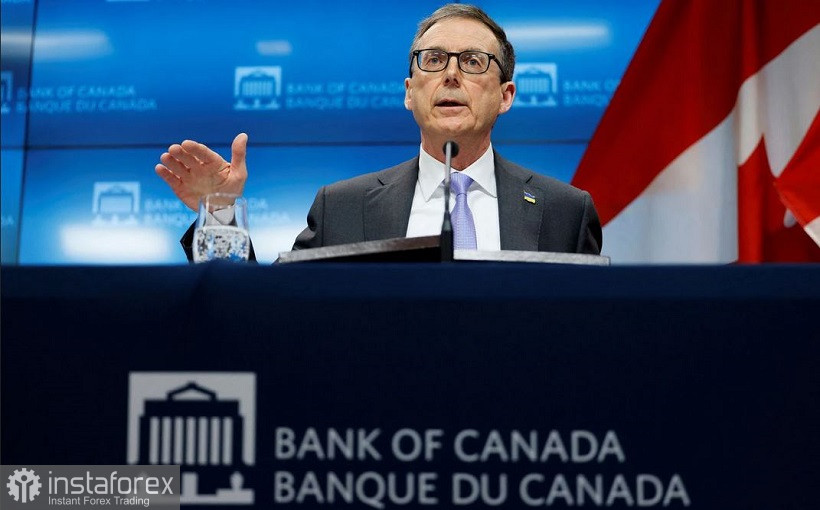The Bank of Canada surprised this week with its hawkish attitude, despite the corresponding expectations from the majority of experts and analysts. According to general forecasts, the Canadian central bank had to raise the interest rate by 75 basis points, that is, up to 2.25%. But the central bank decided to act in a more radical way, raising the rate by 100 points at once. By the way, after this decision, rumors intensified in the market that the Federal Reserve would take a similar step. Recent inflationary releases (CPI, PPI) allow the Fed to take a more hawkish position - inflation in the US not only did not slow down its growth, but also updated a new long-term record. Therefore, the probability of a 100-point rate hike at the July meeting is now estimated at 88%.

But back to Canadian events. If the Fed is still pondering the pace of monetary tightening, the Bank of Canada is already implementing the most hawkish scenarios. Having raised the rate by 100 points, the Canadian central bank announced that it was not going to stop there. Thus, according to the head of the central bank, Tiff Macklem, a "proactive" rate hike will cool domestic inflationary pressures. At the same time, he made it clear that the central bank will maintain a hawkish course. It is noteworthy that in the accompanying statement, the central bank admitted that since the spring of last year, he underestimated inflation due to underestimation of global factors and domestic factors, mainly housing costs. Summing up the July meeting, the Bank of Canada indicated that the increase in interest rates in the short term "will help get out of this difficult period and return to normal life."
The next meeting of the Canadian central bank will be held in September, so Macklem did not talk about the pace of the rate increase in early autumn. Obviously, they will depend on the dynamics of inflationary and other macroeconomic indicators. According to the latest data, inflation in Canada reached a 39-year high of 7.7%. The head of the Central Bank acknowledged that this release was decisive, but not the only argument in favor of such an aggressive tightening: excess demand and rising consumer expectations about rising prices - all these factors played a role. According to the head of the Bank of Canada, further tightening "will be determined by the bank's assessment of the state of the economy and inflation."
Take note that the key macro indicators that have been published over the past few weeks have not failed. For example, the unemployment rate fell to an all-time low of 4.9% in May, on the back of a year-over-year increase in wages and a rise in the number of hours worked. Data on GDP growth in Canada also did not disappoint. The volume of the country's economy grew at an annual rate of 5.0%. In particular, the volume of industrial production (by 0.9%) and retail trade turnover (by 0.9%) increased after a decrease of 0.2% a month earlier.
In other words, if inflation does not slow down its growth until September (and quite significantly), the Canadian central bank will most likely raise the interest rate by another 75 points. Perhaps, the market will regard a 50-point hike as a "dovish scenario". Prior to the July high-profile decision, the Bank of Canada had already raised its interest rate three times this year, hoping to tame inflation to its target level (2-3% range). However, all the actions taken did not bring the desired result, after which the central bank moved to more radical steps.

Separately, it is necessary to dwell on the behavior of the USD/CAD pair this week. The loonie quite adequately reacted to the hawkish results of the July meeting of the Bank of Canada. However, the Canadian central bank, figuratively speaking, let the genie out of the bottle: it was after the decision of the Canadians that the market increased the likelihood that the Fed would also raise the rate by 100 points. The latest inflationary releases in the US paved the way for such a step, but the Bank of Canada "materialized" numerous experts' assumptions.
That is why, after a temporary strengthening of the Canadian currency, the loonie began to actively lose ground. Having dropped to 1.2935, the next day the pair soared to the 1.3220 target, having risen by almost 300 points in a day. By and large, the loonie became a victim of the trading principle "buy on rumors, sell on facts." The US dollar began to enjoy increased demand amid growing hawkish expectations about the further actions of the Fed.
In my opinion, the loonie will not be able to organize a large-scale attack to the downside in the coming weeks. The upward trend is still in force - this is clearly visible on the weekly and monthly charts. Therefore, it is advisable to use the current price declines to open long positions. The first target is 1.3100 (upper line of the Bollinger Bands indicator on the weekly chart). The main upside target is the 1.3220 target, a 20-month price high that was reached this week.





















